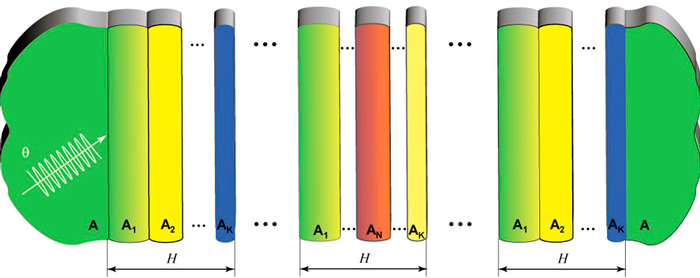Phononic crystals
The composition of the composite material can be very diverse. Their structure is usually periodic or stochastic with special properties. Photonic crystals are also composite materials. They are like photonic crystals and consist of periodic inclusions in a matrix or layers. The concept of phonon crystals appeared in the 1990s, being the continuation of the photonic crystals works. Phonon crystals have different frequency characteristics, such as the possibility of forbidden frequency zones. In the forbidden zone, wave propagation is virtually impossible. This phenomenon can be used in a wide range of technologies and at different fields. The applications include elastic or acoustic focusing, vibration minimization, sound collimation, acoustic masking, optomechanical wave transformations in photonic devices, thermal conductivity reduction in semiconductors, etc.

One-dimensional photonic crystal

Two-dimensional photonic crystal
In addition to the obvious separation by the number of dimensions in which the properties change periodically, phonon crystals can be conditionally divided into three categories: acoustic phonon crystals with a matrix of liquid, elastic phonon crystals with a matrix of solid elastic substance and piezoelectric/magnetic phonon crystals. Recently, the research of phonon crystals has a new trend, namely, instead of traditional phonon crystals, which usually consist of two or more isotropic materials, piezoelectric phonon crystals are created. The most obvious difference between piezoelectric and isotropic materials is the anisotropy and nature of the bond. Such medium properties lead to the fact that the calculation of the medium properties becomes more complex than in the case of phonon crystals from elastic materials. These composite materials have special properties, for example, the magnetoelectric coupling effect, which is not demonstrated by their individual components. Phonon crystals can have forbidden zones-frequencies at which the propagation of elastic waves through the structure is impossible. The existence of forbidden zones in phononic crystals makes it possible for numerous potential applications. For example, phonon crystals can be used as effective sound insulators, useful for acoustic isolation of vibrating structures, gyroscopes or mechanical resonators, and hard coupling devices.


